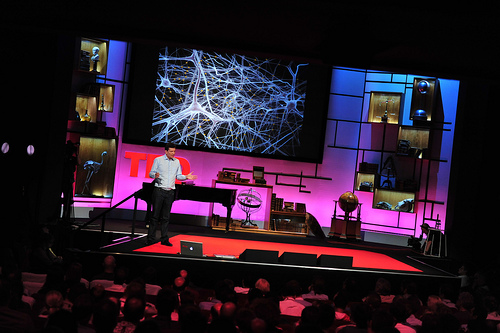
Unedited running notes from TEDGlobal 2009.
Henry Markram is leading the Blue Brain Project, which hopes to create a realistic digital 3D model of the whole human brain within the next 10 years. (The simulation promises to do all the things that real human brains can do, including consciousness.) He’s done a proof of concept by modeling half of a rodent brain. Now he’s scaling up the project to reach a human brain.
But why? It’s essential to understand the brain for us to get along in society. We can’t keep doing animal experimentation forever. We have to embody our data in a working digital model. We need better medicines that are more specific, more concrete, more precise. (Also, it’s just fascinating.)
Markram, for the first time, shares how he is addressing one theory of how the brain works. The theory is that the brain “builds” a version of the universe and projects this version, like a bubble, all around us. But Markram says we can directly address this philosophical question with science. Anesthetics don’t work by blocking receptors. They introduce a noise into the brain to confuse the neurons to prevent you from making “decisions.” You must make decisions to perceive anything. 99% of what you see in a room is not what comes in through the eyes — it’s what you infer about that room.
Instead of speculating or philosophizing, we can actually build something to test the theories.
It took the universe 11 billion years to build a brain. The big step was the neocortex. It allowed animals to cope with parenthood, social functions. So the neocortex is the ultimate solution, the pinnacle of complex design that the universe has produced. The neocortex continues to evolve rapidly. The neocortex uses the same basic unit for computation, over and over again, and built up so fast evolutionarily that the brain had to fold itself up to fit more of the stuff into the skull.
The holy grail for neuroscience is to understand the design of the neocortical column. It will help us understand not just the brain, but perhaps physical reality. Understanding the structures that make it up is extremely difficult, because beyond just cataloging the parts, you have to figure out how they actually work — and then build realistic digital models.
The branches of neurons intersect in millions of locations, and in each location, each synapse, communication happens. The circuit, or the fabric of the brain, the way it is patterned is a challenge to any theory of the brain. Every neuron is different. How is it possible, then, that we create a reality that we all share? Although the circuitry may change, the pattern of design does not change.
Mathematics underlies the models of the brain. Each neuron has a mathematical representation. Even though this simplifies things, you still need a huge computer to do the kinds of simulations Markram is talking about. You’d need one laptop for every single neuron in order to accurately model it. So what do you do? You go to IBM!
“Where is the rose?” is a popular formulation of what the study of cognition is all about. Amid the tangle of neurons, amid the raw, chaotic electrical activity, where is reality — metaphorically thought of as a “rose” one is perceiving or thinking about — actually physically represented? Markram looks at “electrical objects” that neural activity forms, in order to nail down how thoughts are represented.
The universe has evolved a structure for it to become aware of itself. We’re about to create another such structure in the digital universe we ourselves have created.
Photo: Henry Markram at TEDGlobal 2009, Session 5: ” Hidden algorithm,” July 22, 2009, in Oxford, UK. Credit: TED / James Duncan Davidson
Comments (9)